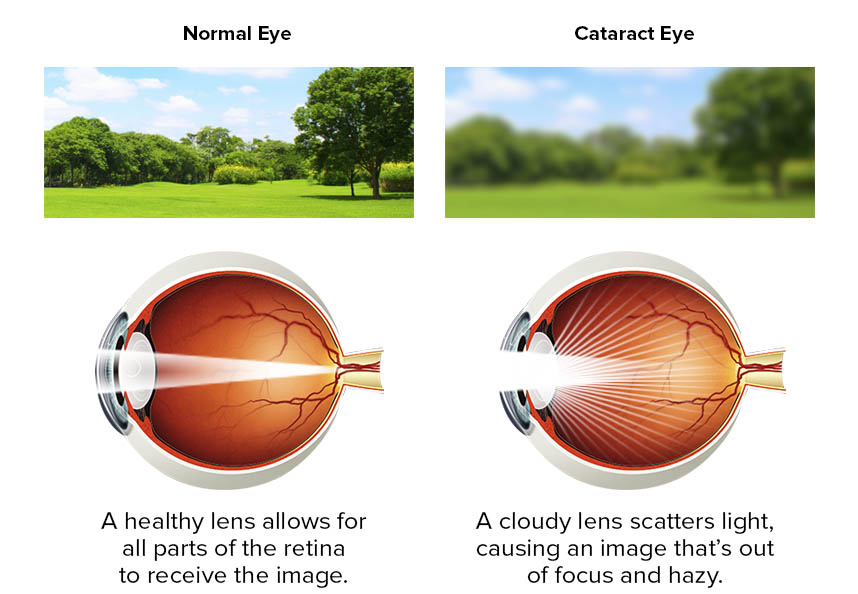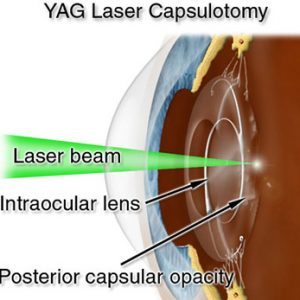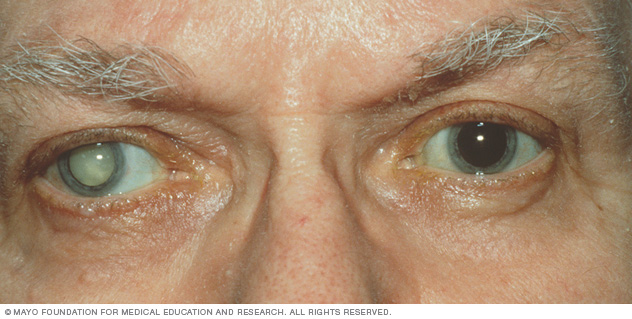cataracts
Don’t wait any longer…See clearly again
Cataracts
Opacity or cloudiness of the crystalline lens, which may prevent a clear image from forming on the retina. Surgical removal of lens may be necessary if visual loss becomes significant, with lost optical power replaced with an intraocular lens, contact lens or aphakic spectacles. May be congenital or caused by trauma, disease, or age.

What causes cataracts?
Cataract development is a normal process of aging, but cataracts also develop from eye injuries, certain diseases or medications. Your genes may also play a role in cataract development.
When is it time for a cataract to be treated?
A cataract may not need to be treated if your vision is only slightly blurry. Simply changing your eyeglass prescription may help to improve your vision for a while. There are no medications, eyedrops, exercises or glasses that will cause cataracts to disappear once they have formed. Surgery is the only way to remove a cataract. When you are no longer able to see well enough to do the things you like to do, cataract surgery should be considered.
What can I expect if I decide to have cataract surgery?
Before Surgery
To determine if your cataract should be removed, your ophthalmologist will perform a thorough eye examination. Before surgery, your eye will be measured to determine the proper power of the intraocular lens that will be placed in your eye. Ask your ophthalmologist if you should continue taking your usual medications before surgery.
You should make arrangements to have someone drive you home after surgery.
The Day of Surgery
At Falgoust Eye Medical & Surgical, Cataract Surgery is done on an outpatient basis through an ambulatory surgery center. You may be asked to skip breakfast, depending on the time of your surgery.
When you arrive for surgery, you will be given eyedrops and perhaps a mild sedative to help you relax. A local anesthetic will numb your eye. The skin around your eye will be thoroughly cleansed, and sterile coverings will be placed around your head. Your eye will be kept open by an eyelid speculum. You may see light and movement, but you will not be able to see the surgery while it is happening.
Under an operating microscope, a small incision is made in the eye. In most cataract surgeries, tiny surgical instruments are used to break apart and remove the cloudy lens from the eye. The back membrane of the lens (called the posterior capsule) is left in place.

During cataract surgery, tiny instruments are used to break apart and remove the cloudy lens from the eye, and an intraocular lens (IOL) implant is placed in the resulting space.
After surgery is completed, your doctor may place a shield over your eye. After a short stay in the outpatient recovery area, you will be ready to go home.
Following Surgery
You will need to:
- Administer the eye drops as prescribed.
- Be careful not to rub or press on your eye.
- Avoid strenuous activities until your ophthalmologist tells you to resume them.
- Ask your ophthalmologist when you may begin driving.
- Wear eyeglasses or an eye shield, as advised.
You can continue most normal daily activities. Over-the-counter pain medicine may be used, if necessary.
Is a laser used during cataract surgery?
Classically, laser surgery was not used in cataract surgery, but new advances in laser technology have allowed the development of lasers that can assist with some parts of the surgery and may provide an additional level of customized precision. Talk with your ophthalmologist to determine if laser cataract surgery is an option for you. Most cataract surgery is performed without a laser and excellent results can be achieved with or with out the laser assistance.
Sometimes the lens capsule (the part of the eye that holds the lens in place) becomes cloudy several months or years after the original cataract operation. This can happen with laser assisted and non-laser cataract surgery. If the cloudy capsule blurs your vision, your ophthalmologist can perform a second surgery using a laser. During the second procedure, called a posterior capsulotomy, a laser is used to make an opening in the cloudy lens capsule, restoring normal vision.

Posterior capsulotomy: a laser is used to make an opening in the cloudy lens capsule.
Will cataract surgery improve my vision?
The success rate of cataract surgery is excellent. Improved vision is achieved in the majority of patients. Only a small number of patients continue to have problems following cataract surgery.
To learn more about cataracts and other common eye conditions, please visit www.geteyesmart.org.
Copyright © July 2004 American Academy of Ophthalmology®




